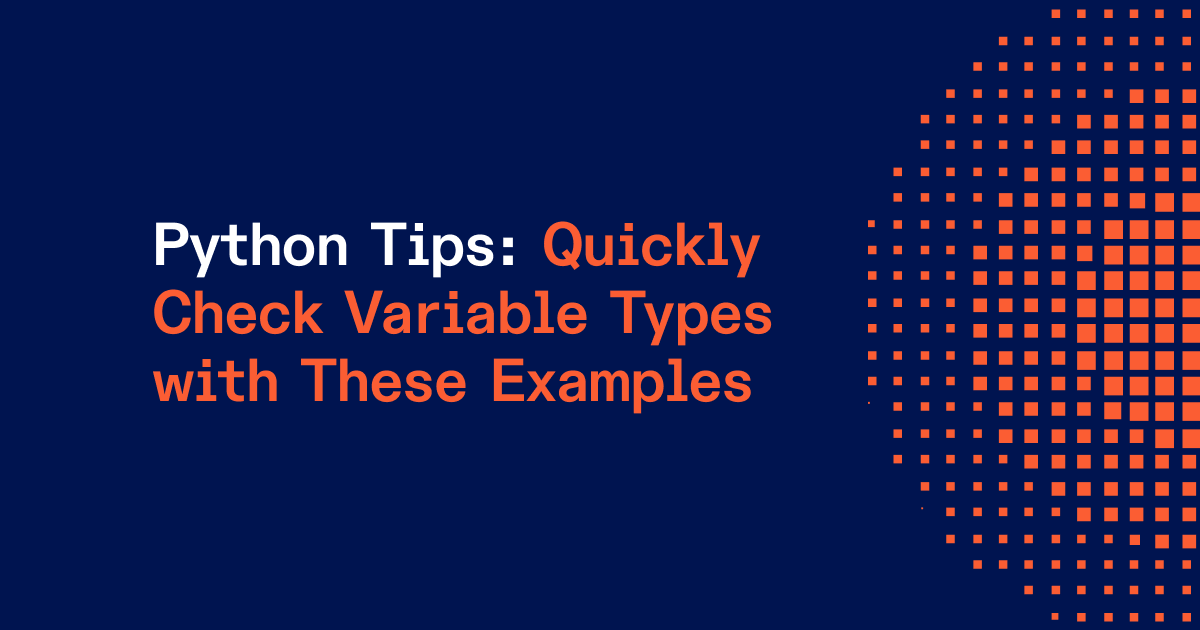Check Python Variable Type: Easy Guide & Examples
Learn various methods to easily identify the data type of a variable in your Python code, from using the built-in type() function to understanding type hints.
Learn various methods to easily identify the data type of a variable in your Python code, from using the built-in type() function to understanding type hints.
In Python, determining the type of a variable is straightforward. You can use the type() function to get the type of a variable. Additionally, the isinstance() function allows you to check if a variable belongs to a specific type. While Python's dynamic typing eliminates the need for explicit type declarations, you can enhance code clarity and maintainability using type hints. Type hints provide information about the expected type of a variable. For more intricate type hinting scenarios, such as function arguments and return values, Python 3.6 and later versions offer the typing module. This module facilitates type specification within your code, aiding in code analysis and early error detection.
To determine the type of a variable in Python, you can use the built-in type() function.
For example, if you have a variable named my_variable, you would write type(my_variable) to get its type.
Python also allows you to check if a variable is of a specific type using the isinstance() function. This function takes two arguments: the variable and the type you want to check against. It returns True if the variable matches the type and False otherwise.
While Python is dynamically typed, meaning you don't explicitly declare variable types like in some other languages, you can use type hints for better code readability and maintainability. Type hints are annotations that suggest the expected type of a variable. You can add type hints using colons after the variable name followed by the type, for example, age: int = 25.
From Python 3.6 onwards, you can use the typing module for more complex type hints, such as specifying types for function arguments and return values. This module provides a way to indicate the expected types within your code, which can help with code analysis and catching potential errors early on.
This Python code demonstrates how to determine and check data types of variables. It uses the type() function to get the type of a variable and isinstance() to verify if a variable belongs to a specific type. The code also illustrates the use of type hints for better code readability and the typing module for more complex type annotations, such as lists of dictionaries. A function get_average_age is defined, showcasing type hints for its arguments and return value. The example calculates and prints the average age from a list of dictionaries, each containing a person's name and age.
# Using type() to determine the type of a variable
my_variable = "Hello, world!"
variable_type = type(my_variable)
print(f"The type of my_variable is: {variable_type}") # Output: <class 'str'>
# Using isinstance() to check if a variable is of a specific type
is_string = isinstance(my_variable, str)
print(f"Is my_variable a string? {is_string}") # Output: True
is_integer = isinstance(my_variable, int)
print(f"Is my_variable an integer? {is_integer}") # Output: False
# Using type hints for better code readability
age: int = 25
name: str = "Alice"
# Using the typing module for more complex type hints
from typing import List
def get_average_age(people: List[dict]) -> float:
"""
Calculates the average age of a list of people.
Args:
people: A list of dictionaries, where each dictionary represents a person
and has an 'age' key with an integer value.
Returns:
The average age as a float.
"""
total_age = sum(person['age'] for person in people)
return total_age / len(people)
people_data = [
{'name': 'Bob', 'age': 30},
{'name': 'Charlie', 'age': 25},
]
average_age = get_average_age(people_data)
print(f"The average age is: {average_age}") # Output: The average age is: 27.5Explanation:
type() function:
my_variable.type(my_variable) returns <class 'str'>, indicating it's a string.isinstance() function:
isinstance(my_variable, str) checks if my_variable is a string, returning True.int returns False.Type Hints:
age: int = 25 and name: str = "Alice" use type hints to indicate the expected types.typing module:
List from typing to specify the type of the people argument in the get_average_age function.-> float annotation indicates that the function is expected to return a float value.This example demonstrates various ways to work with types in Python, from basic type checking to using type hints for improved code quality.
type() and isinstance() can help prevent these errors by validating input.typing Module for Complex Types: Provide more examples of complex types that can be specified using the typing module, such as lists, dictionaries, tuples, sets, optional types, and custom types using TypeVar.type(): Note that type() returns the class of an object. For instances of user-defined classes, it might not be as informative as checking for specific attributes or methods.isinstance(): Mention that for checking against multiple types, using isinstance(var, (type1, type2, ...)) is more concise than multiple isinstance() calls.| Feature | Description | Example |
|---|---|---|
type() function |
Determines the type of a variable at runtime. | type(my_variable) |
isinstance() function |
Checks if a variable is of a specific type. |
isinstance(my_variable, int) returns True if my_variable is an integer. |
| Type Hints | Improve code readability and maintainability by suggesting variable types. |
age: int = 25 suggests age should be an integer. |
typing module (Python 3.6+) |
Enables complex type hints for function arguments, return values, and more. |
from typing import List; def my_function(names: List[str]): ... specifies that my_function expects a list of strings as input. |
This table summarizes the key methods for determining and hinting variable types in Python, enhancing code clarity and robustness.
In conclusion, understanding how to determine and work with variable types is fundamental in Python programming. While the language's dynamic typing provides flexibility, employing techniques like using type(), isinstance(), and especially type hints contributes to more robust and maintainable code. Type hints, facilitated by the typing module for complex scenarios, enhance code readability, facilitate early error detection, and improve overall code quality. By embracing these practices, developers can harness the power of Python's dynamic nature while ensuring their code remains clear, reliable, and easy to maintain.
 The Python type() Function | Python typeof is a built-in function that, depending on the arguments passed, returns the form of the objects/data elements stored in any kind of data or returns a new type object.
The Python type() Function | Python typeof is a built-in function that, depending on the arguments passed, returns the form of the objects/data elements stored in any kind of data or returns a new type object. How to Check the Type of Variable in Python | Learn how to identify Python variable types with clear explanations and practical code examples. This guide also includes links to external resources for further learning about Python's type system.
How to Check the Type of Variable in Python | Learn how to identify Python variable types with clear explanations and practical code examples. This guide also includes links to external resources for further learning about Python's type system. 2 ways to check type of a variable in Python - Python Shiksha | Two important methods for determining the type of a variable in Python.
2 ways to check type of a variable in Python - Python Shiksha | Two important methods for determining the type of a variable in Python. Python Print Type of Variable – How to Get Var Type | If you're a Python beginner, becoming familiar with all its various data types can be confusing at first. After all, there are a lot of them available to you in the language. In this article, I'm going to show you how to get the type of various data ...
Python Print Type of Variable – How to Get Var Type | If you're a Python beginner, becoming familiar with all its various data types can be confusing at first. After all, there are a lot of them available to you in the language. In this article, I'm going to show you how to get the type of various data ... Python Specify Variable Type | W3Schools offers free online tutorials, references and exercises in all the major languages of the web. Covering popular subjects like HTML, CSS, JavaScript, Python, SQL, Java, and many, many more.
Python Specify Variable Type | W3Schools offers free online tutorials, references and exercises in all the major languages of the web. Covering popular subjects like HTML, CSS, JavaScript, Python, SQL, Java, and many, many more. Learning programming: How to determine a Python variable's type ... | Apr 11, 2019 ... You can use either the type() function to get the type of a variable, or the isinstance() function to check against multiple possible types.
Learning programming: How to determine a Python variable's type ... | Apr 11, 2019 ... You can use either the type() function to get the type of a variable, or the isinstance() function to check against multiple possible types. typing — Support for type hints — Python 3.12.7 documentation | Source code: Lib/typing.py This module provides runtime support for type hints. Consider the function below: The function surface_area_of_cube takes an argument expected to be an instance of float,...
typing — Support for type hints — Python 3.12.7 documentation | Source code: Lib/typing.py This module provides runtime support for type hints. Consider the function below: The function surface_area_of_cube takes an argument expected to be an instance of float,... How to Check a Python Variable's Type? - DEV Community | Python's dynamic typing allows developers to write flexible and concise code. However, this...
How to Check a Python Variable's Type? - DEV Community | Python's dynamic typing allows developers to write flexible and concise code. However, this...